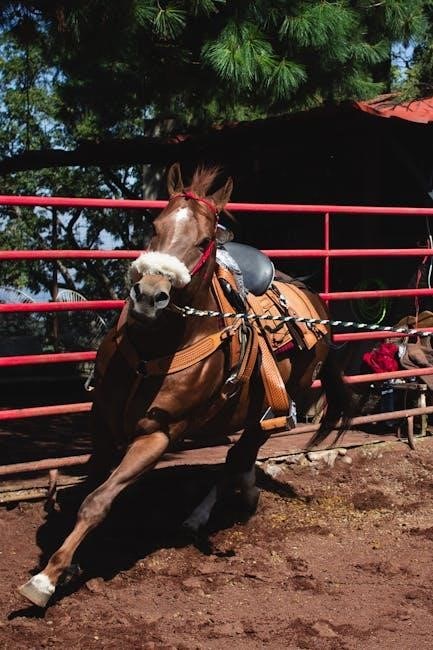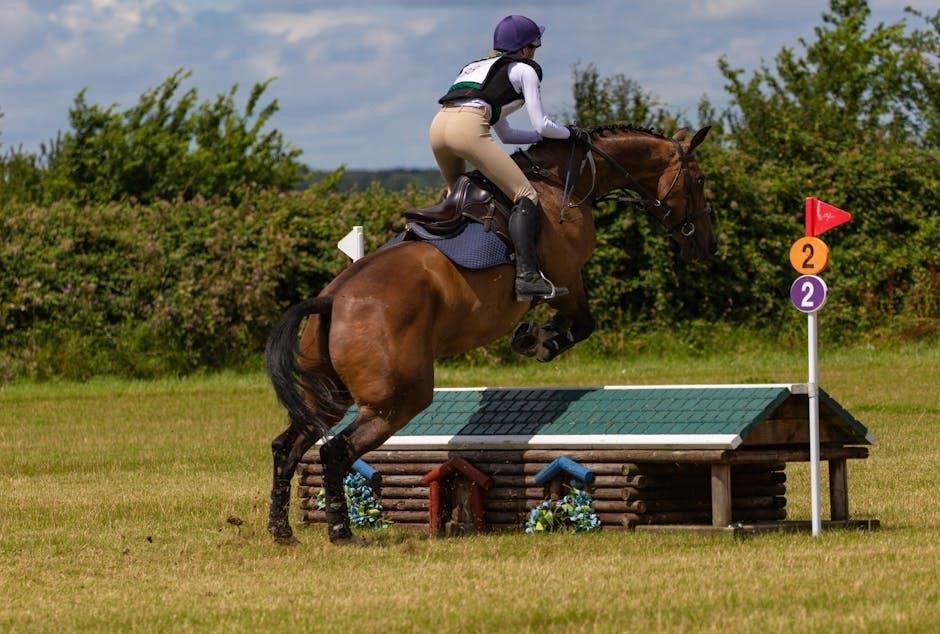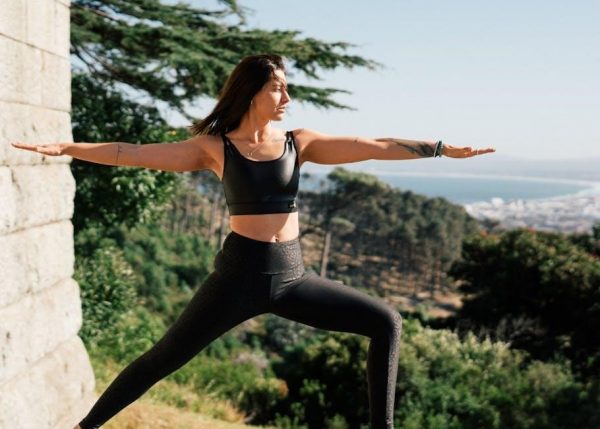An English saddle size guide helps riders determine the perfect fit for comfort and performance. It covers seat size, thigh measurements, and saddle dimensions to ensure proper fit for both rider and horse.

Understanding English Saddle Seat Size
English saddle seat sizes range from 14 to 19 inches, with 17 and 17.5 inches being the most common. Proper sizing ensures rider comfort and optimal performance while riding.
How to Measure Your Seat Size
Measuring your English saddle seat size accurately is crucial for comfort and performance. Sit in a chair with feet flat, knees bent at a 45-degree angle. Measure the upper thigh from the start of the knee to the back of the buttock. This length corresponds to your seat size. Use a flexible measuring tape or a string to ensure accuracy. Generally, seat sizes range from 14 to 19 inches. For example, if your thigh measurement is up to 16 inches, a 15-inch saddle is ideal. If it’s up to 18 inches, opt for a 16-inch size, and for up to 21 inches, choose a 17-inch saddle. Always test the saddle to ensure proper fit and comfort for both you and your horse.
English Saddle Size Chart
An English saddle size chart provides a reference guide to help riders determine their ideal seat size. Generally, seat sizes range from 14 inches to 19 inches, with 17 and 17.5 inches being the most common. To use the chart, measure your upper thigh while sitting with your feet flat and knees bent at a 45-degree angle. For example, if your thigh measures up to 16 inches (41 cm), a 15-inch saddle is recommended. For up to 18 inches (46 cm), a 16-inch saddle is suitable, and for up to 21 inches (54 cm), a 17-inch saddle is ideal. This chart ensures riders can select a saddle that fits comfortably, promoting proper posture and performance. Always refer to the chart and test the saddle to confirm the best fit for both you and your horse.
Key Differences Between English and Western Saddle Sizes
English and Western saddles differ significantly in size and fit. English saddles are generally smaller, with seat sizes ranging from 14 to 19 inches, while Western saddles are larger, often measuring 14.5 to 17.5 inches. A key difference is that English saddle sizes are typically two inches larger than Western sizes for the same rider. For example, a rider using a 15.5-inch Western saddle would likely need a 17.5-inch English saddle. Additionally, English saddles focus on the rider’s seat and upper thigh measurements, while Western saddles prioritize the overall fit for longer rides and different riding styles. The gullet width and tree size also vary, as Western saddles often accommodate broader horse breeds. Understanding these differences is crucial for selecting the right saddle for comfort and performance, whether riding English or Western style.

Measuring for the Correct Saddle Fit
Accurate measurements are essential for a proper saddle fit. Sit in a chair with feet flat, knees bent at 45 degrees, and measure your upper thigh to determine seat size.
Importance of Proper Fit for Rider Comfort
A proper saddle fit is crucial for rider comfort and performance. A well-fitting saddle ensures even weight distribution, preventing pressure points and discomfort during long rides. It also promotes correct posture, reducing the risk of back and joint pain. Improper fit can lead to restricted blood flow, numbness, and fatigue. For optimal comfort, the saddle should accommodate the rider’s seat bones without causing compression. Additionally, proper fit enhances balance and stability, allowing the rider to maintain control and communicate effectively with the horse. A saddle that is too small or too large can disrupt the riding experience, making it essential to measure accurately. Regularly checking the fit ensures ongoing comfort and prevents long-term issues. A correctly sized saddle is an investment in both rider well-being and horse welfare, fostering a harmonious partnership during every ride.
How to Measure Your Upper Thigh for Saddle Size
Measuring your upper thigh is a key step in determining the correct English saddle size. To do this, sit in a chair with your feet flat on the floor and knees bent at a 45-degree angle. Place your hands on your thighs, with your fingers pointing toward your knees, to locate the upper thigh area. Measure the length of your thigh from the back of your buttocks to just below the knee. This measurement will help guide your saddle size selection. Generally, your thigh length in inches corresponds to your saddle seat size. For example, a 16-inch thigh typically fits a 17-inch saddle. Proper fit ensures comfort, balance, and optimal riding performance. Always test the saddle on your horse to confirm compatibility and ensure a harmonious fit for both rider and horse.
Seat Size vs; Flap Length: What You Need to Know
Understanding the difference between seat size and flap length is crucial for selecting the right English saddle. Seat size refers to the measurement from the nailheads on either side of the pommel to the center of the cantle, determining the rider’s comfort and position. Flap length, on the other hand, is the distance from the top of the saddle to the bottom of the flap, influencing the fit for the rider’s leg. While seat size focuses on the rider’s sit bones, flap length accommodates the rider’s leg length and stirrup placement. A longer flap may be needed for taller riders, while shorter flaps suit smaller riders. Balancing both measurements ensures optimal comfort and functionality. Proper alignment of seat and flap lengths is essential for a harmonious riding experience, preventing discomfort or restricted movement. Always consider both when fitting a saddle to ensure the best fit for both rider and horse.
Gullet Width and Tree Size
Gullet width and tree size are vital for ensuring proper saddle fit on your horse. They determine the space and support provided, affecting the horse’s comfort and movement efficiency.
Gullet Width: Ensuring Proper Fit for Your Horse
Gullet width is a critical measurement in English saddle fitting, referring to the space between the two tree points. It ensures the saddle sits correctly on the horse’s back, avoiding pressure points. A gullet that is too narrow can cause discomfort and restrict movement, while one that is too wide may not provide adequate support. Proper gullet width aligns with the horse’s shoulder muscles, allowing free movement and preventing pinching. Measuring the gullet width involves checking the distance between the tree points, ensuring it matches the horse’s anatomy. Regularly checking and adjusting the gullet width is essential, especially as horses develop and change shape over time. A well-fitted gullet promotes long-term comfort and performance for the horse, making it a key factor in selecting the right saddle.
Tree Size: How It Affects Saddle Fit
Tree size plays a crucial role in ensuring proper saddle fit for your horse. The tree refers to the internal frame of the saddle, which determines how it sits on the horse’s back. A correctly sized tree ensures even weight distribution and prevents pressure points. If the tree is too narrow, it can cause discomfort and restrict the horse’s movement. Conversely, a tree that is too wide may not provide sufficient support and can lead to instability. The tree size is measured by the distance between the tree points, which should align with the horse’s ribcage and shoulder muscles. Different breeds or body types may require specific tree sizes, such as medium, wide, or extra-wide. Regularly assessing the tree size is essential, as horses can change shape over time due to age, conditioning, or breed characteristics. A well-fitted tree ensures long-term comfort and performance for both the horse and rider.
Additional Features to Consider
Beyond size, consider materials like leather or synthetic, weight for rider comfort, and features like adjustable pads or reinforced panels for optimal performance and durability in English saddles.
Understanding Saddle Materials and Their Impact on Fit
English saddles are crafted from various materials, each influencing fit and comfort. Leather saddles are traditional, offering a soft, moldable feel that conforms to the rider over time; They provide excellent grip and durability, making them a popular choice for both training and competition. Synthetic saddles, on the other hand, are lightweight and easier to maintain, ideal for casual riders or those seeking a cost-effective option. Faux leather saddles blend the look of real leather with the ease of synthetic materials. Additionally, some saddles incorporate innovative materials like gel or foam padding to enhance cushioning and support. The choice of material directly affects the saddle’s weight, flexibility, and overall fit, ensuring optimal comfort for both rider and horse. Understanding these differences helps riders select a saddle that meets their specific needs and preferences.
The Role of Weight in Saddle Comfort
The weight of a saddle plays a significant role in rider comfort and performance. A lighter saddle can reduce fatigue during long rides, while a heavier one may provide added stability. Material choice greatly influences weight, with synthetic saddles being lighter than traditional leather ones. Riders with stronger physiques or those engaging in endurance rides may prefer lighter saddles for ease of movement. Conversely, heavier saddles, often made from durable leather, offer long-lasting support and are favored by competitive riders. Balancing weight with proper fit and cushioning ensures optimal comfort. Excess weight can lead to discomfort, while insufficient weight might compromise durability. Selecting a saddle that aligns with your riding style, body type, and material preferences is essential for maximizing comfort and performance. The right weight distribution ensures a harmonious riding experience for both rider and horse.

How to Test Your Saddle Fit
Testing your saddle fit involves checking the saddle’s position on the horse, ensuring the seat is parallel to the ground, and evaluating rider comfort and balance. Proper fit ensures optimal performance and comfort for both rider and horse.
Steps to Ensure Your Saddle Fits Both You and Your Horse
Ensuring your saddle fits both you and your horse involves several key steps. First, measure your seat size by sitting in a chair with feet flat and knees at a 45-degree angle, measuring from the back of your buttock to the front of your thigh. Next, assess the saddle’s gullet width to ensure it accommodates your horse’s withers comfortably. Check the tree size to match your horse’s back shape, ensuring even weight distribution. Test the saddle by riding in it, paying attention to your balance and comfort, and observing your horse’s movement for any signs of restriction or discomfort. Regularly inspect the saddle for wear and tear, and consider professional fitting if unsure. Proper fit is crucial for both rider comfort and equine well-being, ensuring a harmonious riding experience.




